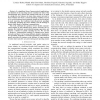Free Online Productivity Tools
i2Speak
i2Symbol
i2OCR
iTex2Img
iWeb2Print
iWeb2Shot
i2Type
iPdf2Split
iPdf2Merge
i2Bopomofo
i2Arabic
i2Style
i2Image
i2PDF
iLatex2Rtf
Sci2ools
INFOCOM
2009
IEEE
2009
IEEE
Identity Aware Sensor Networks
—In a significant class of sensor-network applications, the identities of the reporting sensors constitute the bulk of the communicated data, whereas the message itself can be as small as a single bit—for instance, in many cases, sensors are used to detect whether and where a certain interesting condition occured, or to track incremental environmental changes at fixed locations. In such scenarios, the traditional network-protocol paradigm of separately specifying the source identity and the message in distinct fields leads to inefficient communication. This work addresses the question of how should communication happen in such identity-aware sensor networks. We reexamine the traditional source-identity/message separation and propose a scheme for jointly encoding the two. We use this to develop a communication method for identity-aware sensor networks and show it to be energy efficient, simple to implement, and gracefully adaptable to scenarios frequently encountered in sensor ...
| Added | 24 May 2010 |
| Updated | 24 May 2010 |
| Type | Conference |
| Year | 2009 |
| Where | INFOCOM |
| Authors | Lorenzo Keller, Mahdi Jafari Siavoshani, Christina Fragouli, Katerina J. Argyraki, Suhas N. Diggavi |
Comments (0)

